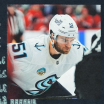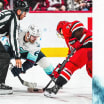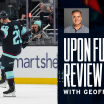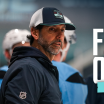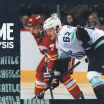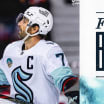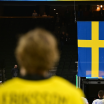With 21-year-old Luke Henman agreeing to his and the team's first professional hockey contract Wednesday, the Kraken's player development group is undeniably and no doubt relentlessly open for business. Let the visible construction of an NHL roster and prospect system begin.
Building out an NHL roster involves numerous steps and "all kinds of different scenarios," says Kraken general manager Ron Francis. Signing Henman is the formal first step, made possible April 30 when NHL commissioner Gary Bettman formally acknowledged Seattle as the league's 32nd franchise with full rights and access upon completing all documentation and expansion fee payments.
Expansion Team Math: From 1 to 30 to 23
Luke Henman is the first name and face among Kraken players and prospects. There will be many more by the end of July. Here's how an NHL roster is built
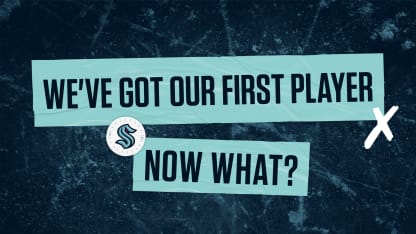
Make no mistake: The Kraken hockey operations group, funded early by team ownership, has been hard at work for two-plus years laying down the foundation of a player scouting and development system, hockey analytics, conditioning/training/nutrition plans and much more to be prepared for the Kraken's upcoming inaugural season (and future years).
Francis and his front-office colleagues can now sign select free agents from North America and Europe who went undrafted and have "aged out" of draft eligibility. Another ongoing free-agent pool is players who were drafted by an NHL team--such as Henman, selected 96th overall in the 2018 amateur draft--but the rights to sign those players expired without an entry-level contract offer (provided they have also "aged out").
In Henman's case, he was drafted by the Carolina Hurricanes in the fourth round but went unsigned as Carolina's rights expired in June 2020. At an "overage" 20 years old, he became a free agent.
There are plenty examples of undrafted free agents or players with expired original-team rights who went on to prosper in the NHL. But hockey executives and prospects alike recognize signing a "two-way" standard entry-level NHL contract (one salary if you make the NHL roster, another if the player continues development in the pro American Hockey League) tends to be a first move to possible NHL ice time.
That's why the standard entry-level contract is between one and three years, to encourage a player's long-term development of skating, hockey skills and what Francis likes to call "thinking the game."
Many players, including surefire Hall of Famers, didn't start their NHL careers until 24 or 25 years old.
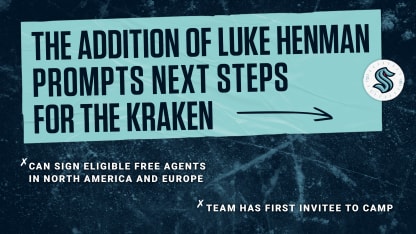
In 2017, Vegas signed Reid Duke as its first player, a 21-year-old forward then playing for the Brandon Wheat Kings of the Western Hockey League, the same league in which the Seattle Thunderbirds and Everett Silvertips play. Duke was originally drafted by Minnesota in 2014 (169th overall) and went unsigned. He has 19 goals and 19 assists in 111 AHL games over four seasons.
A big future step for building the Kraken roster will be July 21's NHL Expansion Draft when Francis, assistant general managers Jason Botterill and Ricky Olczyk and the hockey operations group select 30 players, one each from every NHL team except Vegas (which did not share in the $650 million expansion fee).
"By the [NHL] rules, we are required to select 30 players," says Francis. "And by the rules we can only have 23 players on our active roster."
Let's sort out the Kraken GM's spot-on math. Henman and potential others from this first group of free agents will kickstart the process of adding depth to the Kraken's player development pool. Henman and other possible signees will be invited to the Kraken's first rookie camp leading into the team's inaugural training camp.
The next opportunities for building the opening night active roster of 23 players will come fast and furious in July and early August with a bam-bam-bam sequence of the league's expansion draft (July 21), amateur draft (July 23 and 24) and the beginning of free agency July 28.
Francis and the Kraken brain trust are likely talking with teams about so-called side deals that include stipulations about Seattle selecting or not selecting a certain unprotected player in exchange for an offer of amateur draft picks and/or NHL players or younger prospects in another franchise's development system.
Another point for mock-expansion draftniks: The Kraken will have an exclusive negotiating window from July 18 to July 21 to potentially work out terms of a contract with pending free agents who played for another NHL team this season but were not on protected lists related to the expansion draft. If Seattle signs such a free agent, it counts as the one pick from the player's former team.
As noted, the 30 players selected simply cannot be on the active roster for the first-ever Kraken puck drop on opening night of the 2021-22 NHL season. Seattle is obligated to pick 14 forwards, nine defensemen and three goalies. The other four choices can be any of the three positions.
Twenty of those players must be under contract for the 2021-22 season and their collective salaries must total at least 60 percent of the team's salary cap, which is a league-wide maximum $81.5 million for every team.
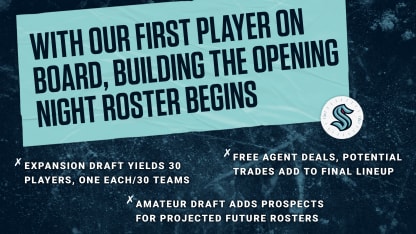
That salary cap is staying flat this year, which means the Kraken front office could use an advantage in trade and free agent talks (the latter being able to offer more money than salary cap-limited teams). With other teams pushing up against the cap, general managers may be looking to offload player contracts in a trade, offering draft choices or additional NHL players and prospects to entice Francis to make the deal, since Seattle will have an amount of "cap room" no other teams enjoy.
The July 23 and 24 NHL Draft will allow the Kraken to begin stocking up on prospects, especially those with high skills and hockey intelligence who are eligible to be drafted. Seattle has a chance to pick in any of the top-five selections, no lower. The Kraken will draft third in Rounds 2 through 7.
Players selected among the first five overall picks do occasionally stick with the NHL team for their first seasons, but it is rare. More likely all of July's draftees, including its top selection, will attend the Kraken's rookie camp leading into training camp, then return to their prior teams for at least one more year of seasoning.
The start of free agency, typically July 1 in pre-pandemic times, will be an exciting time for Kraken fans. Media members have widely speculated Seattle will be active. If the team does make a move, fans can anticipate that player or players would be strong candidate to be among the 20 players who dress for opening night, along with potentially three more who are on the roster and can slot into the lineup when injuries or strategic purposes arise.
The Kraken's inaugural training camp (dates to be announced per league scheduling decisions) will play a big role in determining the NHL roster and which players and prospects join an AHL team for more development as reserve players who will be called up to the Kraken to play games as injuries and/or a prospect's play dictates.
Yet another scenario is the Kraken brain trust might acquire a player on waivers during the preseason when teams are making roster cuts. Trades can be made through the preseason and first half of the season.
"We will look for all ways to build our team in the coming months," says Francis about the drafts and more. "Seeing the official lists [of protected players for the expansion draft] will be a big step. Free agency will be a part of it too, we will look at all those things."

